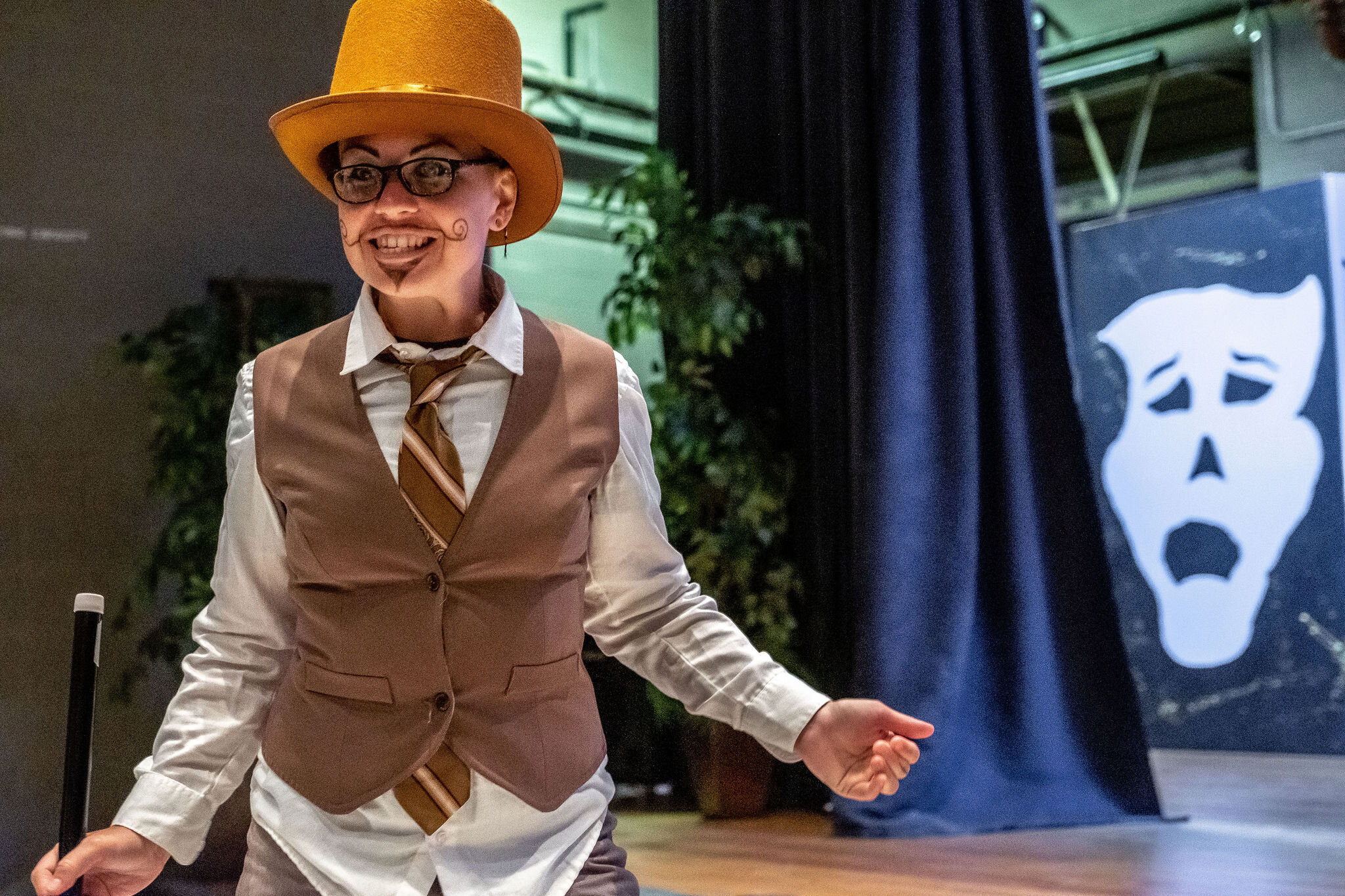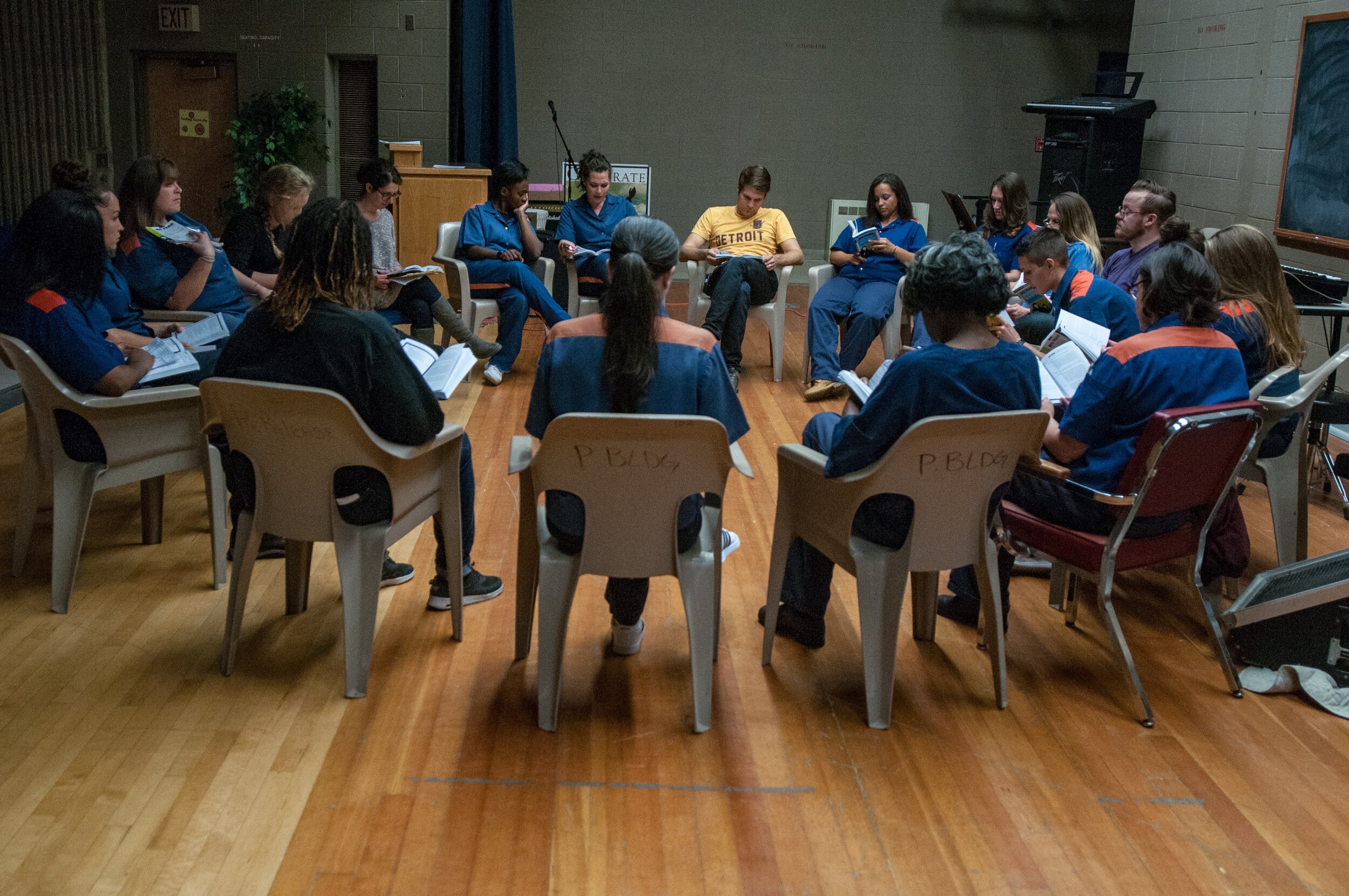Tuesday / February 18 / 2020
Written by Emma
Fair warning, dear blog readers: today’s session was spent talking. It’s that time in the season where we need to start hammering out logistical details including costumes and props, which means a lot of discussion. After quick check-ins and raising the ring, we started talking about themes.
“Can we make it medieval?” a newer member immediately chimed in. When it came to setting, everyone in the group agreed that we should keep it old school—like, 1500s old school. We discussed floppy hats, puffy shirts, and sashes. While thinking about what overall theme we would like the play to have, one woman said, “It’s the unravelling of a family.” Another woman agreed, adding, “Dysfunctional families.”
“A sense of darkness needs to prevail,” added a third. We talked for a while about what this could look like. “Unravelling” can be a very visual descriptor, and the group envisioned a run-down castle with fabric draped in piles. “In all of their lives, everything becomes unravelled,” our Hamlet stated. “They all do.”
Next, we moved on to a discussion of costumes, picking up where we left off with the concept for the Ghost. In a previous session, we had thrown out the idea that the ghost could be wrapped in a type of sheer gauze to symbolize mist. “It’s kinda gotta be like that, don’t it?” the actor playing the Ghost said, “[and] as it changed, [the ghost] would get more comfortable. He doesn’t show his true self until he shows it to Hamlet.” Building off of that idea, someone else suggested that the ghost could have its own sound effect. Similarly, we thought Fortinbras should have his own sound effect to signal the entry and exit of his army. Such audible cues will help the audience follow along with who is doing what, and when.
“We need to decide what scenes are in front of and behind the curtain,” a longtime member said, shifting our discussion to the pragmatic. When should we have our curtain open, and when should we have it closed? A few ensemble members had spent time outside of rehearsal thinking about just this. A woman seated next to me walked me through a detailed idea she had for the first act, stating that she had spent her Sunday conceptualizing what the play could look like.
Next, we spent some time talking about Ophelia and symbolism. Our Ophelia has a conflict and can’t make every session, but she was present this evening, so we were able to get her valuable insights. “I like the symbolism of the flowers,” the woman playing Ophelia said. “[The flowers] could be a present from her father.” We talked about what this could mean. Are flowers inherently comforting? Or would it be better to have her holding a soft object for comfort? “It only needs to be a comfort item to her,” one woman pointed out. Ophelia said that she felt violets best represented the character.
We were quickly running out of time, and excellent ideas were zinging across the circle. Our Osric said of her character, “I wanna be flashy. Extra. Since he’s new money.” She smiled, adding, “Gold lamé, flamboyant.” Others picked color themes that they’d like to have for families. For example, Claudius’ family color is red, and Polonius' family color is blue.
And just like that, two hours of talking had gone by. We had actually almost run out the clock! We were all looking forward to our next rehearsal, armed with some new direction and an overall theme.
Friday / February 21 / 2020
Written by Kyle Fisher-Grant
When I arrived tonight, two different ensemble members came up to me separately and suggested the same plan of action that the facilitators had come up with: to keep check in brief and immediately start on a run of Act 1. I was in no mood to improvise, but even if I had been, I wouldn’t dare mess with the plan created by those women. We still took the time to put the ring up, which was a nice way to start the evening.
Off we went into Act 1 scene 1… and then stopped. Someone was in the wrong spot, and someone else didn’t say their line. The ensemble talked about it for five to ten minutes, and then we restarted the scene.
Off we went! Until we had to stop again a couple minutes later for the same reason. After some more talk, we restarted the scene.
Then we were off again—until we had to stop just a few lines later. This time, a few ensemble members were very visibly and audibly frustrated with the process. I tried to reassure everyone that every production I’ve done—be it in a prison, school, or professional setting—goes pretty similarly. You think you’ve got it down, but putting it all together makes you hit a few snags, and suddenly things are changing. A few of the women were very much attached to the way they had rehearsed the scene previously and had some trouble working in some of the revised blocking. In the end, I told them not to stop again no matter what. We’d watch to see what we thought we could improve and then take another pass at it later.
We moved on to 1.2. The ensemble wanted the scene to open on the royal family finishing a banquet, followed by all the speeches Claudius makes, conducting the official business of the state. This brought up a lot of logistical concerns about how we were going to get the banquet stuff (table, chairs, cups, dishes, silverware, etc.) on and off stage. We talked about the curtain as being a potential tool, and I challenged them to use it only to denote a change in location; furthermore, we should look to the text to find a long enough break to be able to get everything off stage again. For good measure, I added, “A well executed good idea is better than a poorly executed great idea,” a little nod to my directing professor from my college days.
That little phrase actually spurred a larger conversation than I anticipated, and we ended up coming back to it several times before the end of the night. There was a lot of debate; ultimately, I tried to boil down the discussion to three different possibilities, none of which needed to be finalized right that second:
Close the curtain at the end of 1.2 and set 1.3 in front of the curtain (which would mean restaging 1.3);
Close the curtain after the royal family leaves while Hamlet is in the middle of his soliloquy; or
Cut the banquet table.
I suggested that we think about Shakespeare’s original production, which would have been done with almost no set at all, and minimal props. The obstacles are in the text, so that’s where we should look for solutions. With some restaging of the scene, I think we actually covered most of the problems that the banquet was trying to solve, but we will see which way the ensemble wants to go.
In working 1.3, I was much more directorial than is typical of my previous work in SIP. Our goal is to facilitate, not to be directors, and truth be told, it can be difficult at times. I’ve previously described the process as “painfully collaborative,” and, personally, it’s been the hardest balance for me to strike. I am a theatre director at heart, and for my day job I work as a high school teacher—I am very accustomed to calling the shots in the room. Being the only man in the room can also be challenging; taking charge too much could make for a dynamic we need to avoid. So I trod lightly.
There was very little collaboration happening between ensemble members, and I thought that if I could get them started on the scene, they could then take over. I suspected that the group could not see the story unfolding in front of them, and therefore could not contribute. So I kind of took over a bit, set the scene up on solid footing, and explained what I was thinking all along the way so everyone would still be part of the process. I even told a longtime member that she was in charge of telling me if I got too bossy.
So we reworked the scene from the beginning, honing in on staging fundamentals:
Where are the characters?
Where have they just come from?
Where are they going?
Why is Polonius five minutes behind his children?
What is each character's objective?
How can we make that clear on stage?
What does the text say?
In the end, I felt like my strategy paid off, as the room really opened up to the process. The actors felt more confident, and, with that confidence, started trying new things. Our Polonius IMMEDIATELY jumped into gear and worked out two bits right away. She decided that Polonius was late because he was dealing with Laertes’ bags for travel. She entered in huff—with a bag—and she and the actor playing Laertes began a whole schtick handing the bag back and forth. It was great, but it was also confusing, and ultimately the ensemble told her to cut the bit because it detracted from the scene.
But the goal had been achieved, the actors were taking risks, and the ensemble was collaborating. As we approached the end of the evening, a few ensemble members wanted to run 2.1 instead of finishing Act 1. They seemed very enthusiastic, so we switched gears.
It was Polonius and Ophelia, and their interpretation was that Ophelia was looking to Polonius for attention that he didn’t want to give. She had a set of prop flowers that she was using for comfort, and all of her focus was going into the prop. I asked the reason, and, while it came with a fair amount of explanation, I told them that I found it distracting. The point is to see a character in a state of discomfort, and so a “comfort item” was kind of working against her. We tried it again without the prop, and many talked about how much more animated our Ophelia seemed to be. I explained that her energy was going to her scene partner rather than to a prop, and that it seemed to open everything up.
We’ll see what they decide to go with, but, at the very least, we ended the night with a very high level of engagement. Everyone seemed to have an opinion of the flowers-prop, and we went back and forth until it was time to put the ring up. In the end, I think it was a great night, and I’m excited to get back to work later next week.













